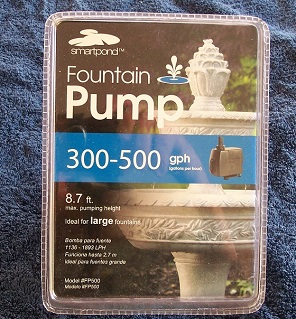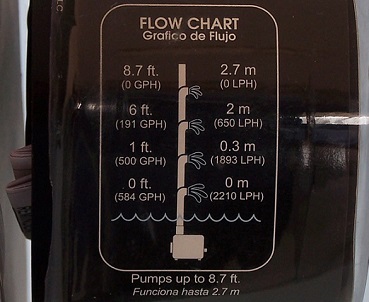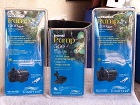How big of a water pump should I get is one of the most asked questions by
new hydroponic growers. But the fact is there just isn’t a specific
answer that fits for everybody. There are just too many variables in
how people can design their h

ydroponic
systems for there to be a clear cut answer that would be able to apply
to every situation. The only answer that would apply across the board
is get a bigger pump than you think you will need, because you can
always reduce the water flow, but you can't do anything to increases
its maximum water flow.
However it’s actually much easier
than it might seem to figure out what pump size you need than you might
think. All you really need to know to do that, is know a few things
about the hydroponic system your building first, and a couple things
about submersible water pumps. Then you'll be able to tell at a glance
if a pump will work for your situation or not.
What you want to know about your hydroponic system first
Water volume and how high you need to pump it
Flood and Drain systems (Ebb & flow)First
you are going to want to know how much water your going to need to
pump. It doesn’t mater what your using for the growing chamber, or how
many of them you have, it's the same simple process to calculate the
water volume. If the container doesn’t have the gallon size written on
it, just fill it up with water to the water level you want, but just
make sure to keep track of how many gallons it takes. That gives you
the water volume you need to fill/flood it.
If you plan to
have multiple growing chambers, just multiply how many growing chambers
you plan to have by the water volume in the one you tested. That
will give you the total water volume you need to fill the entire
system.
After you know the water volume you need to pump, you
will need to figure out how high it will need to pump it above the
water line in the reservoir. For that you will need to know where your
going to be putting the system and reservoir. As an example, if
your putting the system (growing chamber) on top of a table, and the
reservoir on the ground near it, the system will probably be somewhere
between 2 and 3 feet above the water line in the reservoir. If your
mounting the system along a fence or wall, the height could be much
different. Knowing how high the pump will need to pump the water up
from the reservoir is a very important aspect of picking a pump
(probably even the most important thing to know).
Once
you know those two things about your hydroponic system, then you can go
ahead and pick a good pump for your system. For more on picking the
right pump, scroll down to the section on “What you should know about
water pumps for Hydroponics.”
Drip SystemsWhile
drip systems are simple in nature, there are hundreds of different ways
to construct them. But that also means there is almost no end to the
variables that could affect the water flow from the water pump. However
the same two things you need to know to pick a pump for a flood and
drain systems are ultimately the same for all systems (including drip
systems), “Water volume and how high you need to pump
it.”
Naturally deciding on how much water
(GPH) you want/need to run through your drip system is more difficult
to calculate than a flood and drain system. It's not as important
because your not flooding a system in a specific time period, your just
giving the plants a gentle soaking that can last 15 min, hours, or even
24/7. And you can easily adjust the soaking time with a timer.
Because
of things like the size of your plants, how many plants your growing,
the type of growing media your using, how much growing medium there is
for each plant, how you built your system, if your using a timer to
control the watering cycles, as well as how long between the watering
cycles, even humidity levels, the amount of water volume you want to
reach each plant per hour (GPH) can vary drastically. So there is no
easy or set formula to go by for that. But as mentioned earlier,
as long as each plant is getting a steady amount of dripping, you can
adjust watering/wetness with a timer.
When considering a water
pump for a drip system, water pressure will be the key to it working
well. The more plants and dripprs you have, the more water pressure you
will need. Submersible pumps used for hydroponics don't give pressure
ratings (psi). They only give gallons per hour (GPH) and “head height”
(max height it can pump). The the higher the head height, the more
water pressure the pump will have. Scroll down to read more about it in
the section “What you should know about water pumps for Hydroponics.”
NFT SystemsWith
a NFT system you don’t need to fill the system (growing chamber), you
just need a constant flow 24/7 to all the plants. The water depth is
shallow, only a few millimeters (¼ inch or so). So you don’t need a
large volume of water to be pumped through it. Typically NFT systems
are constructed using long tubes that are angled so the water flows
downhill as it flows through the tube. The angle of the tube will
control the water depth, as well as the speed in which the water flows
through it (not the pump). The pump just needs to be able to keep up
with how fast the water is flowing out of the tubes.
With the
water depth being just a few milometers, you only need to pump a few
gallons per hour through each tube. It doesn’t need to flow fast, but
you definitely don't want it to be stagnate. Stagnate water will become
depleted of oxygen and nutrients quickly. Flowing water will provide a
continues supply of both.
The water depth and flow rate
will be the biggest factors in the gallons per hour you will be
pumping. As an example, with a water depth of ¼ inch deep, and 4 inch
wide tube, a 10 foot long tube will hold about ½ gallon of water. If
you want to recirculate that half gallon of water every 5
minutes, that would give you 6 gallons per hour through each
tube.
If you wanted the flow rate to be faster and changed the
angle of the tube so it was recirculating that half gallon of water
every 2-½ minutes instead, then you would be pumping twice as much
water at 12 gallons per hour. The length of the tube in your NFT system
isn’t really important, and wont affect the flow rate or GPH you need
to pump. It will only affect the total amount of water needed in your
system, but not how fast you recirculate it.
Now that you can
figure out the GPH you will need to pump through each tube in your NFT
system, just multiply it by the amount of tubes you plan to have in
your system to get the total minimum GPH. But always get a pump that
can pump more than you need. And don't forget to take into account how
high it needs to pump it. For more about pumps, scroll down to the
section on “What you should know about water pumps for Hydroponics.”
Aeroponic SystemsThere
are two types of aeroponic systems. The true aeroponic system uses high
pressure (60-90 psi). However most people refer to low pressure
spraying systems as aeroponic systems as well.
High pressure
aeroponic systems don't really use a water pump due to the numerous
cycle (on/off) times needed. They usually consist of a two sided
tank with a rubber divider. The nutrient solution is in one side. And
air in the other. Then an air compressor is used to pressurize the
tank. A water line from the nutrient solution side runs to the misting
heads, and a solenoid is used to open and close a valve in
the water line at precise times using a cycle timer.
Low
pressure aeroponic systems are what most people are referring to when
they mention aeroponics. Low pressure systems use standard submersible
water pumps, but still need a good amount of water pressure or the
water will just trickle out of the sprinkler/mister heads. The more
sprinkler heads your using, the more water pressure you will need.
Unfortunately submersible pumps don't give a psi rating to compare.
They only give you GPH and head height, and GPH is a measure of volume,
not pressure. Your best indicator of water pressure is the “head
height” rating. It takes pressure to pump water up, so the more GPH it
can pump higher, the more water pressure it will have.
What you should know about water pumps for Hydroponics

The
water pumps used for hydroponics are just simply submersible fountain
and pond pumps that you can get at most home improvement stores. Some
manufactures also package them specifically for sale at hydroponic
supply stores.
Once you know the minimum number of
gallons you need to be pumped through your system, it's easy to choose
a pump. But we would recommend to make sure you choose a pump that can
pump at least twice as much water than the minimum gph of what you
need. That will allow you some flexibility in how you set things up,
changes in the future, as well as make sure the pump doesn’t fall short
of your expectations.
You can always easily reduce the water
flow from a pump if you need to, but you cant ever make it pump more
than it was designed to. Most pumps will have a flow restrictor built
in, it's just a cover that slides/pivots over the opening for the water
inlet to reduce the water inlet opening size.

If
you need to reduce the water flow even further, the easiest way to do
it is just install a “T” connector in the tubing going to your plants,
just above the pump and still inside the reservoir (like in the picture
on the right). Then install a short piece of tubing on it so half the
water goes straight back into the reservoir. If you want to fine tune
the water flow even more, you can also add a valve on the end to adjust
how much water goes back into the reservoir.
GPHGPH stands for
Gallons Per Hour,
and all the pumps will have the maximum gph listed in easy sight on the
package. If the pump gives a range like 300-500 gph, it's usually
because it has two different size adapters. Using the smaller one will
give you the the smaller max gph, and using the larger adapter would
give you the higher max gph. But the max gph is only at ground/water
level, or one foot high depending on the manufacture. The higher up the
pump needs to pump the water, the lower the gph it actually puts out
will be. That's called “Head Height.” Some pump manufactures will give
a chart or list the max gph at different heights.
Now make sure to keep in mind that GPH is
per hour,
not per minute. If you want to know the gallons per minute, just divide
the gallons per hour by 60. That's important to keep in mind,
especially if you are getting a pump for a flood and drain system. You
don't want it to take an hour to finally flood your system, you'll want
to be able to flood it in just a few minutes. As an example if you need
50 gallons of water volume to flood the system, and you want it to
fully flood within 10 minutes, that’s 1/6th of an hour (50x6=300) . So
that would equal
5 gallons per minute, and/or 300 gallons per hour minimum.
Head HeightThe
higher the pump needs to pump the water up (vertically not the amount
of tubing it is pumping through), the more back pressure there is on
the pump from the weight of the water and gravity. The point when
there is more back pressure on the pump than the pump can put out is
the “ Max Head Height.” At the water line there is no back pressure on
the pump, and that's when you will have

the maximum water flowing that the pump can provide. If it needs to
pump 3 feet high before it gets to where it's going, there will be 3
feet of back pressure that the pump needs to overcome before any water
can flow out.
When choosing a pump, it's important
to keep in mind how high up from the water line in the reservoir it
will be pumping up to. After all, because of head height the actual gph
it can pump to that height can be much different than the max gph on
the front of the package. Most manufactures give you some kind of chart
showing the max gph at different heights to judge by.
Always
look for the pump that has the highest head height for the price range.
While submittable pumps don't give you a psi (pressure) rating, it
takes pressure to overcome the back pressure. So the pumps with the
highest head height and thus can overcome the most back pressure, will
naturally have the highest psi as well.
Cleaning the Pump and FiltersSubmersible
pond and fountain pumps are just electromagnets. The coil is in the
main body, and the impeller shaft has a magnet. Water can get
in-between the impeller shaft and main body, and it acts like a
lubricant. There are just a few basic parts, the main body, the
impeller and shaft, the flow restrictor, impeller cover, and inlet
opening cover. It can be taken all apart and cleaned. You should get
used cleaning the pump with every nutrient solution change. It's easy
to do especially when you do it regularly. Just take it apart and use
regular dish soap and a sponge or brush.

The
pump you get may or may not come with a filter/screen. But don't worry
because even if it doesn’t, you can easily make one cheap from common
things. First you want to take the water inlet cover off. For about two
or three bucks you can get a furnaces filter screen from any hardware
store, and some places like walmart like the one in the picture on the
right.
Just cut out the white screening out to use as your
filter screen. Then just cut a piece to fit snuggle inside the water
inlet cover. Then just place the cover back on. You can also use the
blue swamp cooler pads as well, or even a cheep sponge as long as it
doesn’t have a side for scrubbing, just the foam side. As for cleaning
the filter all you need to do is put a dab of soap on it and work it in
under running water, then rinse it out thoroughly.







